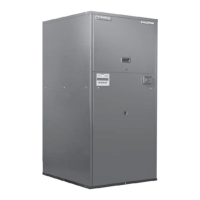82
EVCA Modulating Fire Test Procedures and Specifications
APPENDIX D (Cont…) - TSBC
TM
SETUP Menu
Display
Factory
Settings
Range Description
Low
Fire
Hold
20 10 to 1200 (s)
Time modulation rate is held at present value (Low Fire Spd or Fan Purge Spd
depending on the state and configuration of spare input) after the Fuel Valve
Energized Input (CS) is energized.
Post
Purge
Time
30 0 to 600 (s)
Time modulation rate is held at Fan Purge Spd after the Fuel Valve Energize Input
(CS) is de-energized.
Local
Pid
P
20 0 to 10000
Proportional Gain value for boiler outlet temperature sensor control Modes. A larger
gain value results in tighter, more active, PID control. Gain is the primary PID
modulation rate tuning adjustment and provides the immediate modulation rate
response.
Local
PID
I
30 0 to 10000
Integral gain value for boiler outlet temperature sensor control Modes. A smaller
value makes the Integral ramp in less time (i.e., faster). Integral is a secondary PID
modulation rate tuning adjustment that ramps the output over time (typically
minutes).
Local
PID
D
0 0 to 10000
The Derivative gain value for boiler outlet temperature sensor control Modes. A
larger Derivative gain value produces a larger PID output contribution proportional to
the rate of change of the error (Setpoint – Boiler Outlet Temperature). When set
equal to zero it has no effect on the output.
Remote
PID
P
20 0 to 10000
Proportional Gain value for Remote System Temperature sensor control Modes.
Refer to Local PID P for explanation.
Remote
PID
I
30 0 to 10000
Integral Gain Term for Remote System Temperature sensor control Modes. Refer to
Local PID I for explanation.
Remote
PID
D
0 0 to 10000
Derivative Gain Term for Remote System Temperature sensor control Modes. Refer
to Local PID D for explanation.
Mixing
Valve
P
10 0 to 10000
Proportional Gain value for boiler Inlet temperature sensor control mode. A larger
gain value results in tighter, more active, PID control. Gain is the primary PID
modulation rate tuning adjustment and provides the immediate mixing valve
modulation response.
Only visible when mixing valve = yes.
Mixing
Valve
I
60 0 to 10000
Integral gain value for boiler inlet temperature sensor control mode. A smaller value
makes the Integral ramp in less time (i.e., faster). Integral is a secondary PID
modulation rate tuning adjustment that ramps the output over time (typically
minutes).
Only visible when mixing valve = yes.
Mixing
Valve D
0 0 to 10000
The Derivative gain value for boiler inlet temperature sensor control mode. A larger
Derivative gain value produces a larger PID output contribution proportional to the
rate of change of the error (Setpoint – Boiler Inlet Temperature). When set equal to
zero it has no effect on the output.
Only visible when mixing valve = yes.
Max
Delta T
P
10 0 to 10000
Proportional Gain value for boiler differential (boiler outlet minus inlet temperature
sensor) temperature control mode. Refer to Local PID P for explanation.
Only visible when mixing valve = yes.
Max
Delta T
I
60 0 to 10000
Integral Gain value for boiler differential (boiler outlet minus inlet temperature
sensor) temperature control mode. Refer to Local PID I for explanation.
Only visible when mixing valve = yes.
Max
Delta T
D
0 0 to 10000
Derivative Gain Term for boiler differential (boiler outlet minus inlet temperature
sensor) temperature control mode. Refer to Local PID D for explanation.
Only visible when mixing valve = yes.
D. SETUP MENU (continued)

